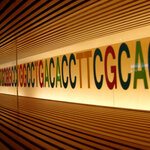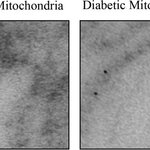Genetics & Molecular Biology

One of developmental biology's biggest mysteries is ontogeny and the signals that transform masses of undifferentiated cells into tremendously complex organisms.
A new paper suggests that it all begins with a single "master" growth factor receptor, nuclear Fibroblast Growth Factor Receptor 1 (nFGFR1), that regulates the entire genome.
The research using mouse embryonic stem cells hopes to challenge the supposition that specific types of growth factors only functioned at a cell's surface and that growth factors function from within the nucleus.
A more advanced…

When the chemotherapy drugs like cisplatin or oxaliplatin hit cancer cells, they damage DNA so that the cells can't replicate but those cells have ways to repair the DNA and so the cancer drugs aren't as effective as they could be.
When DNA is damaged, cells use many enzymes to cut the strand of DNA and excise the damaged fragment. Then, other enzymes repair the original DNA so that the cells can function properly. Previously, Sancar's lab used purified enzymes to discover how this process happens in DNA damaged by UV irradiation and by chemotherapeutic drugs such as cisplatin and…

"Organoids", a futuristic-sounding term for three-dimensional cultures derived from tumors of cancer patients, closely replicate key properties of the original tumors - so close that these "organoid" cultures could be used for large-scale drug screens for the detection of genetic changes associated with drug sensitivity and pave the way for personalized treatment approaches.
To study the causes of cancer and develop new cancer treatments, many laboratories use experimental model systems such as cells grown from patient tumors. However, currently available cell lines may have been…

We all know how irritating it is to have an inbox flooded with junk mail.
Fortunately email providers these days contain filters to keep the junk mail at bay.
As a result the junk mail folder tends to pile up with never-to-be-read emails.
But, occasionally, an important email is snagged by the filter and is unduly ignored.
We can think of the human genome as a server sending out a constant bombardment of emails. These messages are on average 2,000 letters long, and these “letters” are made up of different types of bases, some of which are packaged in the form of RNA.
Up until about two…

A new study has created a cause-and-effect link between chronic high blood sugar and disruption of mitochondria, the energy factories that create the metabolic energy that power most of our cells.
Previous experiments by other research groups had shown that the high blood sugar of untreated diabetes alters the activity of mitochondria, compartments that process nutrients into useable energy for cells. To find out why, postdoctoral fellow Dr. Partha Banerjee compared the enzymes in mitochondria from the hearts of rats with diabetes to those from healthy rat hearts. He looked for…

To understand how transposable elements, DNA sequences capable of moving independently, shape genomes, where they are maintained over generations, it is vital to discover the mechanisms behind their targeted integration.
Researchers from the Laboratoire Pathologie et Virologie Moléculaire (CNRS/Inserm/Université Paris Diderot), Institut de biologie intégrative de la cellule and the University of Minnesota have identified an interaction between two proteins that is essential for the integration of a transposable element into a specific area of the yeast genome. The results…

Researchers have developed and used a new technique to connect the dots in the genomic puzzle. Just as dots have to be connected to visualize a full picture, the researchers connected regulatory elements called promoters and enhancers and showed their physical interactions over long distances within the mouse and human genomes.
The ability to map promoter-enhancer interactions in the human genome has huge potential in understanding the genetic basis of disease.
Our development as an embryo and the establishment of different cell types in the body is dependent on a suite of genomic regulatory…

A new soybean with significantly reduced levels of three key proteins responsible for both its allergenic and anti-nutritional effects has been created. Soybean is a major ingredient in many infant formulas, processed foods and livestock feed used for agriculture.
Conventional soybeans contain several allergenic and anti-nutritional proteins that affect soybean use as food and animal feed and in the U.S. alone, nearly 15 million people and 1 in 13 children suffer from food allergy. In California, parents who think exposing children to measles, mumps and rubella should be…

In biology class you learned that DNA (deoxyribonucleic acid) is the main component of our genetic material and it is formed by combining four parts: A, C, G and T (adenine, cytosine, guanine and thymine), called bases of DNA. These bases combine in thousands of possible sequences to provide the genetic variability that enables the wealth of aspects and functions of living beings.
In the early 1980s, the four "classic" bases of DNA sort of got a fifth - methyl-cytosine (mC), derived from cytosine, which was later linked to epigenetic mechanisms because it is able to switch genes on or off…
Producing sperm is necessary to procreate and but procreation only happens the first time in those birth control public awareness films. In most cases, sperm must be produced continuously, and for an extended period of time, to insure reproduction.
A new study reveals that there are differences in reactivity to retinoic acid in spermatogonial stem cells, and these differences are a key factor to the persistence of sperm production with inexhaustible stem cells.
In mammalian testis, sperm are produced for most of the male's lifetime. The spermatogonial stem cells are immature germinal…